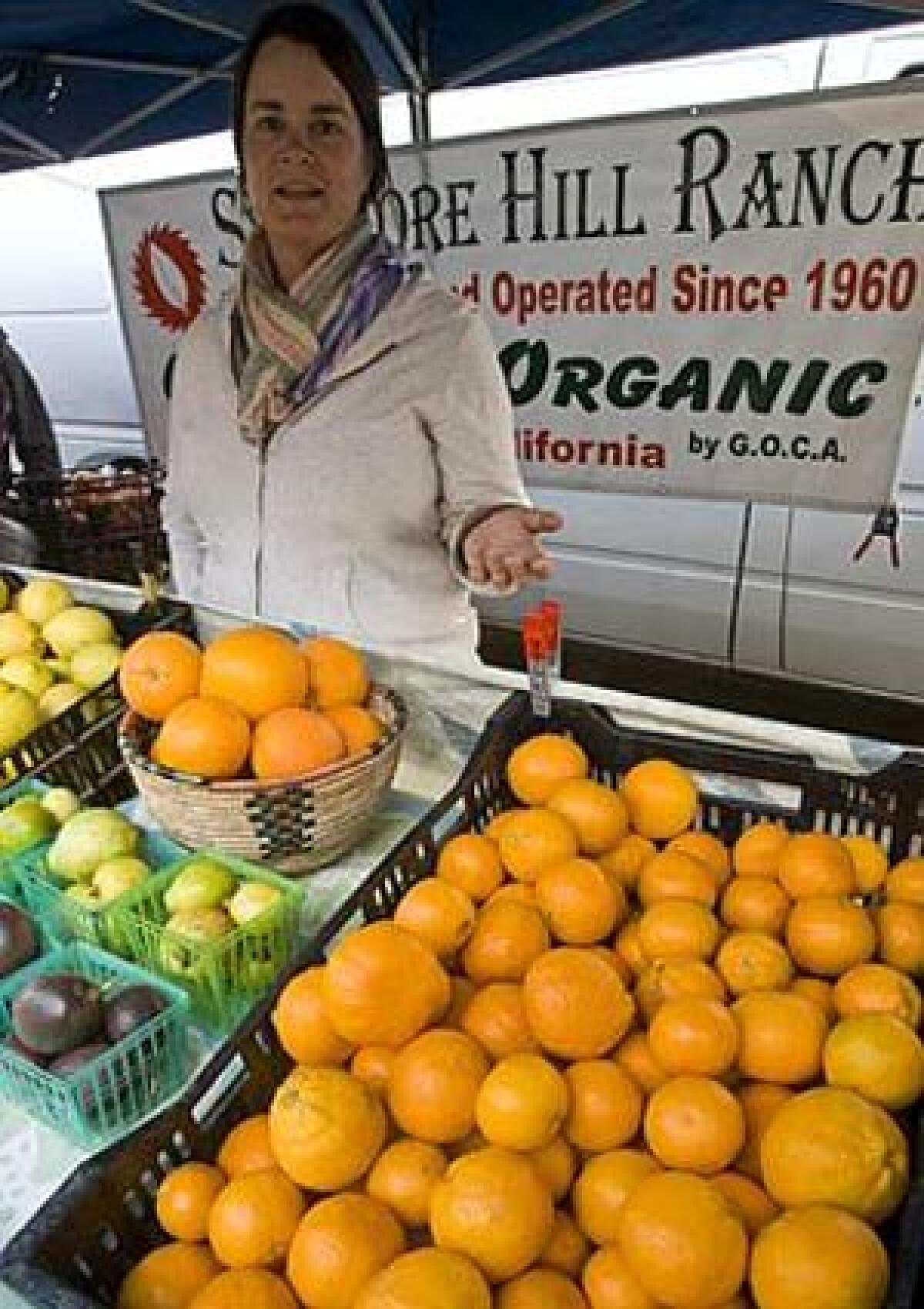Market Watch: When citrus is past its prime

- Share via
What’s new and good?” is the natural question to ask at a farmers market. But in choosing citrus, particularly at this time of year, one must also be aware of the equally important flip side: “What’s past its prime?” The symptoms of overmaturity are crucial but not always obvious.
Compared with other fruits like peaches or berries, many varieties of citrus hang on the tree for a long time, but like the best of us, they eventually grow old and decline. Farmers market growers, in contrast with commercial producers, have a natural incentive to stretch out the season as long as their supplies last, and they therefore may sell past best quality.
Let the buyer choose, or beware, seems to be the operating principle of many a vendor.
For their part, shoppers often find a citrus variety they like and stick with it too long; the deterioration in fruit quality from week to week can be so imperceptible, they may not realize that it’s time to move on to a more seasonal selection.
Admittedly, tastes differ, and the same fruit that tastes pleasingly sweet to one person may seem insipid to another. Even citrus professionals such as farmers and scientists differ in their tastes, but the key signs of overmaturity that they look for are blandness, off flavors and overly soft or dry texture.
For example, Satsuma mandarins may have been the best citrus available in November, and still pretty good from some areas into February, but by March they are inferior. Most have loose, puffy skins; their flesh has lost so much acidity that it’s bland; and the aromatics have subtly shifted so that the fruit has an “old” flavor. I like to use the rule of thumb: If you can stick your thumb through a citrus fruit, fuggedaboudit!
With their thin skins and delicate aromatics, mandarins are arguably the most delicious form of citrus when at their best, but are most susceptible to deteriorate when overmature. Grapefruits and pummelos keep much longer in good condition on the tree, at least up to a certain point. Oranges, natural hybrids of mandarin and pummelo, are intermediate in keeping quality.
Each growing area has its own calendar of maturity. The earliest district is the low desert, after which come the San Joaquin Valley, the inland districts of Southern California (such as Fallbrook, Valley Center, Riverside, Redlands, Santa Paula and Fillmore), Ojai and finally the more coastal and northerly areas (Ventura, Camarillo, San Luis Obispo).
For example, Moro blood oranges from the San Joaquin Valley are at their peak in January. By March and April, they can have deep violet pulp — almost black — because the fruits are packed with anthocyanins, and also because the pigments change from red to violet as acidity drops with advancing maturity. Though dramatic, these superdark fruits usually have lost so much acidity that they taste flat, and they also tend to develop an unpleasant musty aroma. Moros mature a month later in Southern California, where they can retain good flavor into April, or even later in some years. In the San Francisco Bay Area, some late blood varieties don’t sweeten until September.
Among citrus fruits intended to be eaten fresh (that is, excluding the acid types like lemons and limes), the key to quality is a good balance of sweetness and acidity. Acidity in most such citrus drops over time so that it eventually tastes mildly sweet, but watery, without the refreshing tang that characterizes citrus at its best.
A puffy rind, with open space between the skin and the fruit ball, is one of the main symptoms of overmaturity, especially in mandarins, while in old oranges and grapefruits the rind is more typically creased. An open core is a similar indicator. Pebbly skin, with bumps, is different; it can be a sign that a fruit comes from a juvenile tree, which is typically associated with coarser flesh and inferior flavor. However, some varieties, like Gold Nugget mandarin, can have rinds that are naturally somewhat rough, so it helps to be familiar with a variety before judging.
Some citrus varieties from low-humidity inland areas are susceptible to granulation, a physiological disorder in which the juice vesicles near the top (stem end) of the fruit dry out and become ricey in texture. A little bit of granulation, limited to the top, is not necessarily fatal, but it’s usually a sign of declining quality. Fully or largely granulated fruit is inedible and grounds for a refund. Usually larger specimens of a variety are more advanced in maturity and more likely to be granulated.
Citrus types and varieties vary greatly in flesh texture, from the naturally firm (pummelos) to the naturally tender (Cocktail “grapefruit”). Texture becomes a problem when a variety that is supposed to offer a pleasant resistance to the teeth, like a Fukumoto navel orange in November, becomes unpleasantly soft and mushy later on.
Many vendors offer samples, and this of course should be the decisive test, but even tasting is not completely dependable. Maturity within a batch of the same variety can vary markedly depending on a fruit’s date of bloom and position on the tree. Fruits fully exposed to the sun can be sunburned, that is, lighter in color, drier and blander. (Early in the season, of course, they might be sweeter than shaded fruit.) Pixie mandarins are in prime season right now, but while most in a batch I tasted recently were in perfect condition, a few had clearly been cooked by the sun.
More to Read
Eat your way across L.A.
Get our weekly Tasting Notes newsletter for reviews, news and more.
You may occasionally receive promotional content from the Los Angeles Times.









